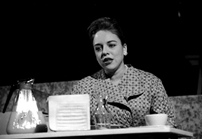

Light comedy and heavy turmoil in American suburbia are hardly hot topics at Oberlin, but, thanks to Trouble in Tahiti, at least we can take a peek into a day in the life of Bernstein's "opera in seven scenes."

The Oberlin Musical Theater Association opens its 1997-98 season with Tahiti this weekend; the show runs through Saturday. Tahiti recounts the conflict of a bored, yet very married couple and their search for the "harmony and grace" of old love and the proverbial Garden of Eden.
Essentially a character sketch, Trouble in Tahiti centers its themes relating to people, their needs and their dreams. Through the course of the piece, the American dream becomes nothing but light projected on a silver screen, the magic of the movies replacing real life. Gender plays a big role, especially in relation to marriage and sensitivity.
The lead male role, Sam, played by conservatory sophomore Marc Callahan, is almost a caricature of the stereotypical '50s man of the house. His humor comes less from actual entertainment and more from the fact that it's impossible to take such men seriously these days. From that perspective, Sam provides a social contrast between then and now.
Everything about Dinah, the lead female character in Trouble in Tahiti, says Woman. She is a mother, a cook, a wife, a dreamer. Conservatory senior Erica Salinas plays the role with great sensitivity, for the most part, but her shining moment is the comedic interlude. Here, Salinas takes the utmost advantage of lyric, physical, and even vocal comedy.
Conservatory senior Keely Rhodes, college sophomore Sarah Rooney and college first-year Caleb Stokes comprise the Chorus, which acts as a reminder that the good old days have been replaced by swinging suburban dissonance. It is here that hope lives on the silver screen, where all of America's dreams come true.
With Trouble in Tahiti, one doesn't have to be a techie to appreciate a fantastic set. The multi-tiered stage adds variety; color contributes to the division of stage left and stage right, to the segregation of man and woman. Director Alison Ostergaard, OC '97, deserves praise for her brilliant use of space. Such painstaking attention to detail brings both actors and audience closer to the heart of Tahiti.
Perhaps the most disturbing element of the production was the space. Wilder Main does its guests no favors in terms of layout or acoustics. In that sense, all designers and performers had physical difficulties to overcome. Whereas the singers had the lungs and stage presence to make themselves understood, such an insensitive space made their success all the more impressive.
Trouble in Tahiti is a directing masterpiece. The cohesive, dynamic structure of the performance as a whole enables it to stand alone amidst the throes of peril.
Trouble in Tahiti shows tonight and Nov. 1 at 8 p.m. in Wilder Main. Tickets are $3 in advance and $4 at the door.
Flashback to the'50s: Conservatory senior Erica Salinas plays Dinah, half of Bernstein's wistful American couple in Trouble in Tahiti. The performance runs through Saturday. (photo by Michael Lando)
Copyright © 1997, The Oberlin Review.
Volume 126, Number 7, October 31, 1997
Contact us with your comments and suggestions.